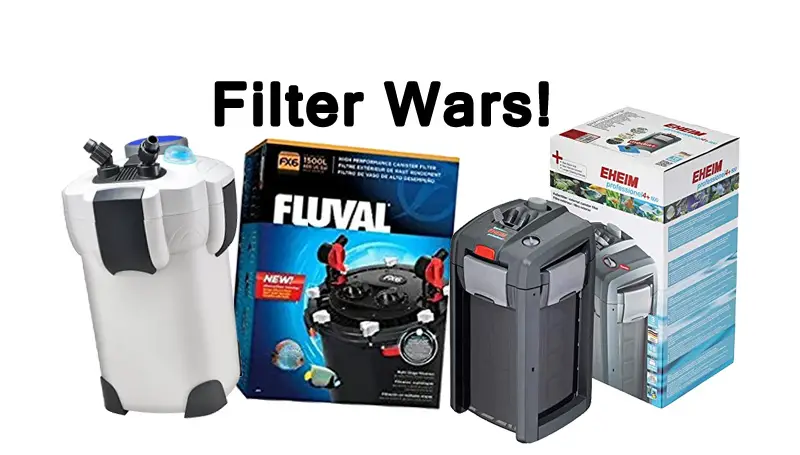If you’re a fishkeeper, an aquarium hobbyist, then you’ve probably heard that the Fluval FX6 is the best canister filter money can buy. In fact, some would argue that it’s the best filter of any kind that money can buy.
However, the truth usually isn’t so clear cut when it comes to picking out the right product for you. And that’s the rub: the right product for you. Because, sure, maybe X filter has better build quality, but Y filter has the feature that you need, and Z filter fits in the cabinet under your stand. So, when people tell you “it’s the best, you gotta have it” remember to take that with a grain of salt.
And I guess that’s why you’re hear? You’ve heard that the FX6 is the best, but you wanna know about equivalents and alternatives. So, in this article I want to investigate equivalent products. Additionally, the goal is to help you figure out not which aquarium filter is the best, but rather, which aquarium filter is right for you.
Major Players In The Aquarium Canister Filter Game
- Fluval
- Eheim
- SunSun
There are other canister filter manufacturers out there, like Penn Plax and Marineland, and while they do make good filters, I’m going to be focusing on the two top dogs—Fluval and Eheim—and the affordable SunSun alternative.
Fluval, Eheim, & SunSun Model Overview
For the purposes of this article, it’s important to know what manufacturers have available and how those products compare. To keep it simple, here is a list of filter models and their associated flow rates and filter media capacities.

*Capacity info for SunSun products currently unavailable.
Fluval FX6 Vs. Eheim 2262
These are the two powerhouses of the canister filter world. For a long time, Eheim felt like the reigning world heavyweight champion of the filter world. But, Fluval’s flagship FX6 is a filter to be reckoned with.
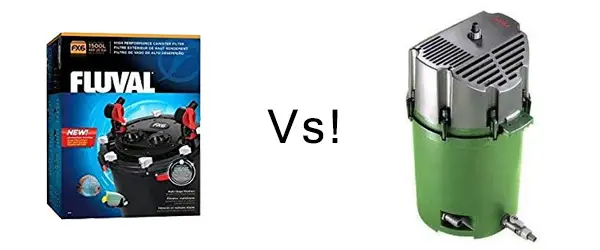
Let’s consider each filter’s flow rate. The Eheim 2262 is rated at 900 gallons per hour, whereas Fluval’s FX6 has a flow rate of 925 gallons per hour. So, those numbers are comparable.
In terms of filter media capacity, the Eheim 2262 has 4.75 US gallons of space for filter media. The FX 6, though, beats it with 5.28 US gallons of space for filter media.
Fluval FX6 Vs. Eheim Professional 4+ 600
The FX6 has an unparalleled flow of 925 US gallons per hour, while Eheim’s Pro 4+ 600 lags behind at 330 US gallons per hour.

These Fluval and Eheim products are priced differently, thereby accounting for the difference in muscle. Check out current prices on Amazon, here for the FX6 and here for the Eheim Pro 4+ 600 (NB* affiliate links).
Concerning media capacity, Fluval take the win again; the FX6 has over five gallons of storage space, whereas Eheim’s closest offering gives around 2.5 gallons.
The Eheim Pro 4+ 600 has a unique “xtender” feature which is intended to extend time between maintenance. This is a switch on top of the canister which allows the user to enable an alternative flow route when the original flow route is slowed or clogged.
Fluval’s FX6 features a nice drain valve, to which a hose can be connected to allow for easier drainage and maintenance. A feature I like, is the FX6’s top mounted dials that allow you to set the date of your last maintenance and water change.
Fluval FX6 Vs. SunSun 704
SunSun canister filters are affordable, and I mean affordable. So, if you’re on a budget then I’d recommend taking a look at their range.
The considerable difference in price plays out in the performance numbers, though. The SunSun 704 has a flow rate of around 528 US gallons per hour. Which, of course, is a strong flow. But, at the time of writing, nothing comes close to Fluval’s FX6 at 925 US gallons per hour.
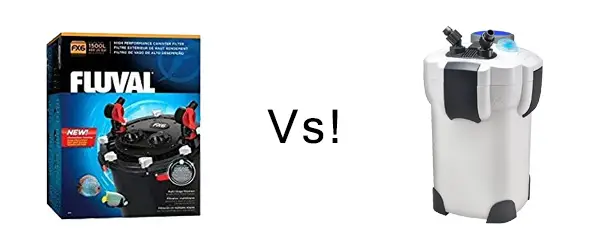
The SunSun filters do offer an interesting feature. You’ll notice that this manufacturer has A and B models of its canister filters. For example, the 704A and the 704B. This indicates whether the filter has a built in UV sterilizer or not; specifically, the B models have the UV filter, whereas the A models do not.
It’s important to know, though, that the UV bulb will gradually cause the plastic filter media trays to break down. Therefore, they will need to be replace periodically if the UV bulb is used.
Furthermore, there is debate among aquarium hobbyists as to whether a UV filter is necessary in most scenarios. Typically they are used on koi ponds to prevent green water, but they are effective on any microorganisms floating in the water. If your fish are generally hardy, which most aquarium fish are in my opinion, then you likely do not need to run a UV sterilizer in your aquarium. However, if you have very valuable fish (either money-wise, or emotion-wise) then perhaps a UV sterilizer could offer you peace of mind.
Fluval FX6 Vs. Fluval G6
That’s right, Fluval is competing with Fluval in the canister filter market. And it’s a smart move from them, because while the two products are ostensibly the same thing, the reality is that they possess key differences.
Put simply, the FX6 is the beast, the work horse, the monster filter for your messy fish! Whereas, Fluval’s G6 is the kind of fancy tech that the aquarium hobby needs to see more of.
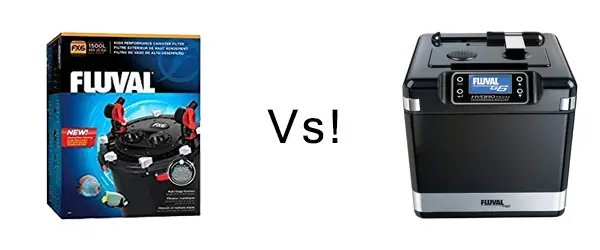
If you’ve read this far, then you already know that nothing compares with the FX6’s flow rate. And the G6 is no different. At 265 US gallons per hour, the flow rate isn’t bad, but the FX6 smashes it at 925!
However, the G6 isn’t about its flow rate, nor its canister capacity (2.3 US gallons). The Fluval G6 is about cool features.
For example, the first feature to stand out is the G6’s display screen on the front of the canister. The display screen provides useful information. For example, it lets the user know if there is air in the system! Additionally, it provides conductivity details, it measures temperature, and flow rate. Especially useful for newcomers to the hobby, the G6 will alert the user when it’s time to perform maintenance on the unit.
Do I Even Need A Canister Filter For My Aquarium?
It’s a good question. Because there’s a reasonable chance you actually might not need one.
Pros:
- Easily concealed filter equipment.
- Configurable media (i.e. sintered glass, ceramic, foam, etc).
- Strong flow.
Cons:
- Out of sight out of mind, difficult to know when to do maintenance.
- Possible clogging, efficiency reduced with water not flowing evenly over media.
- Can become a snail farm for MTS (Malaysian trumpet snails).
Canister filters can be good for that one, big, stunning show tank in your living room. They’re also excellent if you have some large fish that make a lot of waste, and that waste needs sucking up post haste. Although, if you want to get the best out of your canister filter, developing a good sense for when you need to work on the media (i.e. keeping it clean and unclogged) is vital. If you’re new to the hobby, it might be worth regularly checking on your filter’s media. Until you get a feel for when maintenance is needed, a quick visual check helps.
However, if you have multiple tanks in a fish room, then it’s probably financially unreasonable to outfit each aquarium with a canister filter. Additionally, the power consumption would be on the high side. Lastly, think of all the maintenance—opening and cleaning each filter on the regular.
So, before you buy a canister filter, make sure you really need one. After all, there’s a reason a lot of seasoned fishkeepers just go for an air pump and a sponge filter!
Hang On Back Filters Vs. Canister Filters
Hang on back, hang on the back, or hob filters, are an interesting alternative to a canister filter. Unlike a canister filter, which sits under your aquarium, a hang on the back does exactly as you’d expect: it hangs off the back of your tank.
This means you have much easier access to the filter’s media for when you need to clean it off / unclog it. However, generally the media compartment is much smaller than a canister filter’s. But, because the media compartment is open and at the back of your aquarium, you are able to add marginal plants to the media compartment. Any plants that grow out of your filter box will eat up excess nitrogen compounds in your water. Be aware though, that the roots from plants growing in your HOB filter will make cleaning the media much more difficult.
Like a canister filter, though, a HOB filter has a powered motor and therefore it can provide a comparable flow rate.
In my opinion, the best hang on the back filters available are the AquaClear range. Buy an AquaClear HOB filter from Amazon here (affiliate link).
Sponge Filters Vs. Canister Filters
Now this really is comparing chalk and cheese. A sponge filter has no moving parts of its own, it’s just a sponge, a tube, and a weighted base. Water passes over the sponge, which works as biological and mechanical filtration, only when connected to a air pump (sold separately, of course). Whereas, a canister filter has a powered impeller to suck the water out of the aquarium, it then drives it over the media and back into the tank.
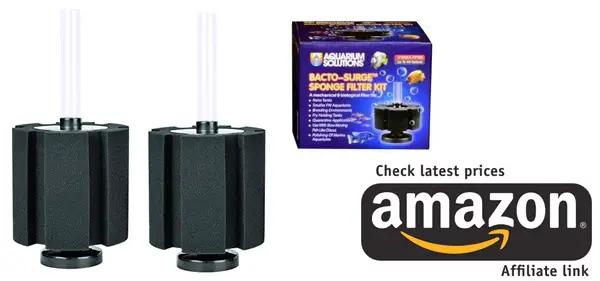
A canister filter provides strong flow, lots of filter media, different types of media layered for efficiency, and the majority of the equipment exists outside the aquarium. Whereas, a sponge filter has a much weaker flow (depending on the strength of the associated air pump), but it is easier to clean and will not break down. Furthermore, the weaker flow of a sponge filter is actually beneficial in many scenarios—for example, if you have fry or very small fish in your aquarium, then a strong flow could be deadly!
In my breeding tanks, I use the BactoSurge sponge filters. Grab them here, on Amazon (affiliate link).
Conclusion
As I mentioned in the introduction to this piece, which filter you choose for your aquarium really depends on your personal context.
If I have a big tank, with big fish then I’m naturally going to opt for the FX6 (if I can afford it). Whereas, if I’m on a budget with a display tank, then the SunSun is for me. Perhaps I want a very easy maintenance experience, but I still want a pump with a strong flow; well, in that case I’d have to go for a hang on the back filter. And last but not least, the humble sponge filter is something I use in all my breeding tanks because I don’t want the fry to get sucked up into the filter!
Made Your Choice? Grab Your Aquarium Filter Now!
Further Reading
- Your Filter Broke, Now What?
- What To Do About An Overstocked Aquarium
- Finnex Vs. Fluval: The Best Aquarium Light

